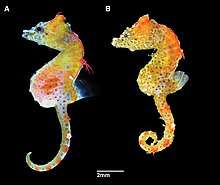Japanese pygmy seahorse
The Japanese pygmy seahorse (Hippocampus japapigu), is a Japanese species of seahorse in the family Syngnathidae.[1] It is also sometimes known as the Japan pig.[2]
| Japanese pygmy seahorse | |
|---|---|
 | |
| A is the male, B is the female | |
| Scientific classification | |
| Kingdom: | Animalia |
| Phylum: | Chordata |
| Class: | Actinopterygii |
| Order: | Syngnathiformes |
| Family: | Syngnathidae |
| Genus: | Hippocampus |
| Species: | H. japapigu |
| Binomial name | |
| Hippocampus japapigu Short, Smith, Motomura, Harasti & Hamilton, 2018 | |
Distribution and habitat
It lives in Northwestern Pacific near Japan, and lives at depths from 5 to 22 meters deep, but its usually found at 10 to 13 meters deep,[1] but doesn't live with any specific species to host, and instead clings onto algal turfs in subtropical reefs.[3]
As of 2018, H. japapigu is only known to be found in Japan, including Kashiwa-jima Island, Sukumo Bay; Kushimoto, Kii Peninsula; Osezaki, Izu Peninsula; the Izu Islands of Miyake and Hachijo; Sagami Bay; and Chichi-jima, Ogasawara Islands.[4]:44
The type locality was collected off Imasaki, Okago, Hachijo-jima Island, Izu Islands at a depth of 10 m (33 ft).[4]:30
Description and feeding
It reaches a length of 1.6 cm, and contains 28 tail rings, 14 dorsal fin rays, 9 pectoral fin rays, and 4 subdorsal rings.[1] It is the size of a jellybean, and its coloration is made for hiding in algae-covered reefs, clinging to soft corals while feeding on plankton, and has a pair of wing-like protrusions on its neck, unlike other species, it contains only 1 pair instead of 2, and is the only seahorse in the world known to have a bony ridge running down its back.[2]
Taxonomic history
In 2013, after completing his PhD on the biology of the Bargibant's and Denise's pygmy seahorses, Richard Smith went to a fish biology conference in Okinawa in 2013 after which he photographed the Japanese pygmy seahorse on several dives off of Hachijo-jima, one of the Izu Islands about 180 miles from Tokyo. There he found about a dozen specimens.[5]
The species description was published by Short and colleagues in a 2018 issue of ZooKeys; it was based on one female holotype, a male and a female paratype, and two photographs of additional specimens. The holotype and one paratype were deposited at the Burke Museum at the University of Washington; the other paratype was deposited at the Kagoshima University Museum.[4]:30
Short and colleagues proposed Japanese pygmy seahorse as the English and Japanese common names for the species. The specific epithet comes from its colloquial Japanese name: Japan Pig or Japapigu.[4]:45
References
- Capuli, Estelita Emily (2019). Froese, R.; Pauly, D. (eds.). "Hippocampus japapigu". FishBase. Retrieved 8 April 2019.
- Jewett, Katie (2018). "Academy scientists describe 229 species in 2018". California Academy of Sciences. Retrieved 2019-04-08.
- "Japanese Pygmy Seahorse". Dr Richard Smith - Ocean Realm Images. 2018-08-03. Retrieved 2019-04-08.
- Short, Graham; Smith, Richard; Moromura, Hiroyuki; Harasti, David; Hamilton, Healy (2018). "Hippocampus japapigu, a new species of pygmy seahorse from Japan, with a redescription of H. pontohi (Teleostei, Syngnathidae)". ZooKeys. 779: 27–49. doi:10.3897/zookeys.779.24799.
- Smith, Richard (Dec 2018). "The More You See, The More You Know". Wildlife Australia. 55 (4): 20–21.